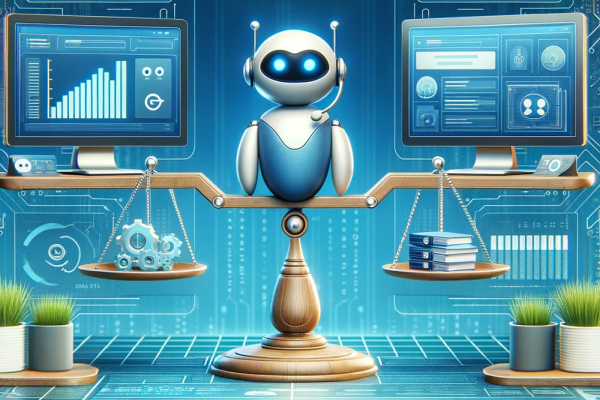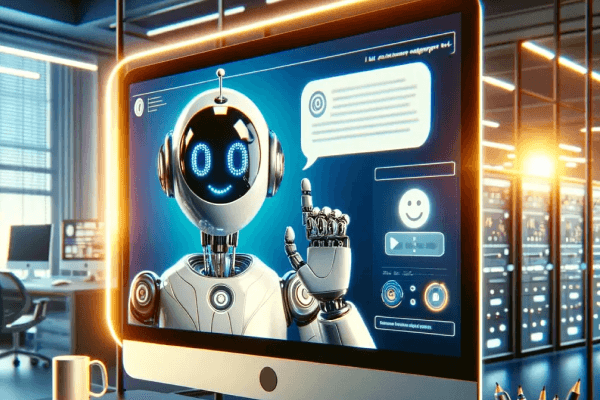Fast answers or human empathy? Why not both? Businesses today are blending AI tools with human agents to deliver better customer support. Here’s what you need to know:
- AI excels at handling routine questions 24/7, reducing costs, and speeding up responses.
- Humans are best for complex issues, emotional understanding, and personalized solutions.
- Customers prefer: 69% want quick self-service options, but 86% still choose humans for tricky problems.
Quick Comparison
| Aspect | AI Support | Human Support |
|---|---|---|
| Strengths | Fast, 24/7, cost-efficient | Empathy, problem-solving |
| Weaknesses | Struggles with emotions | Higher costs, slower response |
| Best Use Cases | Routine questions, FAQs | Complex issues, sensitive topics |
The future of customer support lies in combining AI’s efficiency with the empathy of human agents. Keep reading to learn how to create the perfect balance.
AI Support Capabilities
AI-driven support is changing how businesses interact with customers by providing fast, round-the-clock assistance. This consistency allows companies to tap into AI’s strengths in customer service.
AI Support Benefits
With AI support, customers receive instant, 24/7 responses, ensuring they get help when they need it. These tools also lighten the load for human agents by handling routine queries, allowing staff to focus on more complicated issues – all while maintaining the company’s tone in communications.
Current AI Support Tools
Today’s AI platforms come packed with features designed to make customer service more efficient. Resolve247.ai, for example, offers two standout tools:
- AIChatbot: This tool delivers instant, round-the-clock assistance. It includes features like seamless transitions to human agents, automatic translations, and integration with a knowledge base.
"Some customers need a quick answer and are happy to get it from our AIChatbot – don’t make them wait for a human. Other customers simply want to talk to a Human – so use ResponseAssistant to help your Support Team respond quicker." – Sam Cox, Founder at Resolve247.ai [3]
- ResponseAssistant: This tool supports human agents by pre-drafting responses that align with the company’s style. It uses past interactions, integrates with ticketing systems, and creates initial drafts to speed up replies.
AI Support Challenges
While AI support offers numerous benefits, it does have its limitations:
- Emotional Understanding: AI often struggles with complex emotional scenarios that require real empathy. It can pick up on basic sentiment but lacks the depth needed for more sensitive situations.
- Handling Complex Issues: AI excels at solving straightforward problems but can fall short when dealing with intricate, multi-layered issues or unique cases that demand creative thinking.
- Accuracy Concerns: Context-specific queries, outdated knowledge bases, and highly technical or culturally nuanced questions can sometimes trip up AI systems.
To address these issues, providers like Resolve247.ai implement measures such as anti-hallucination guarantees and frequent updates to their knowledge bases. These improvements help ensure more accurate and reliable AI interactions, making it easier to combine AI with human support effectively.
Human Support Strengths
Human agents bring an unmatched ability to understand emotions and provide personalized solutions, which fosters customer loyalty. This complements the speed and efficiency of AI, creating a powerful hybrid support model.
Human Agent Benefits
Human agents stand out in customer service, with 52% of professionals identifying empathy as the main reason customers prefer human interaction [4].
Here’s what they bring to the table:
- Active Listening: They carefully listen to customer concerns, ensuring accurate and tailored solutions [1].
- Complex Problem-Solving: Using their experience, they handle challenges that AI can’t resolve.
- Collaborative Solutions: They draw on team insights to find the best answers [1].
These advantages shine in scenarios where AI falls short, as outlined below.
Must-Have Human Support Cases
Some situations require a human touch to ensure customer satisfaction. Businesses should ensure the option of human support is available in the following areas:
| Scenario Type | Why availability of Human Support is Essential |
|---|---|
| Financial Services | Personalized advice for complex financial decisions |
| Healthcare Support | Empathy for sensitive, health-related inquiries |
| Complex Technical Issues | Dynamic troubleshooting for multi-layered problems |
| High-Value Accounts | Personal attention for strategic client relationships |
Interestingly, customers over 40 are 30% more likely to prefer human interaction [2]. This preference becomes crucial in:
1. Benefits and Complex Services
Human agents excel in explaining intricate benefits. A survey found that 76% of employees reported higher job satisfaction when they received personalized guidance [5].
2. Conflict Resolution
"A competent agent with great listening skills can make an interaction seem effortless. Strong listening comprehension skills enable agents to quickly understand the issue and get right down to problem solving." [5]
3. Custom Solutions
Businesses that assign human agents to handle complex issues – like cancellations and refunds – see better results [6].
To get the most out of human support, companies should reserve it for high-impact cases, leaving routine inquiries to AI. This approach ensures that human expertise is used where it matters most, benefiting both customers and the business.
Combining AI and Human Support
Let’s dive into how blending AI and human expertise can transform customer service. A winning strategy combines AI’s speed and efficiency with the empathy and problem-solving skills of human agents. Research reveals that 69% of consumers are open to AI-driven experiences, while 83% prefer to resolve complex issues through a single point of contact [8].
AI and Human Support Working Together
Modern customer support systems use AI for routine tasks, freeing up human agents to handle more intricate issues. This balance works well – AI chatbots can cut call volumes by up to 30%, and automated email sorting can reduce response times by as much as 50% [9].
One practical example is the use of AIChatbot for instant responses, paired with a smooth transition to human agents when needed. In this setup, AI manages repetitive questions around the clock, while human agents step in for situations requiring judgment or a personal touch. The result? Faster responses and happier customers. Below, we’ll explore how to bring these strengths together effectively.
sbb-itb-bd61b1a
Guidelines for Mixed Support
Here’s how AI and human support can work together seamlessly:
| Support Area | AI’s Role | Human’s Role | Integration Method |
|---|---|---|---|
| Initial Contact | Handle basic inquiries | Manage escalations | Automated routing system |
| Complex Issues | Provide relevant data | Make final decisions | AI-assisted human support |
| Follow-up | Automate check-ins | Conduct personal outreach | Automated workflows |
These principles help align AI’s strengths with human expertise. Transparency about AI usage, clear options for human support, and regular monitoring of performance are key to success.
Studies show that 42% of customers value a mix of AI and human support, and 50% of support agents prefer this collaborative approach [4]. This balance not only meets customer expectations but also supports agents in their roles. Next, we’ll look at how to set up and implement this hybrid system effectively.
Setting Up Mixed Support
To create a balanced AI-human support system, focus on understanding your needs, choosing the right tools, training your team, and keeping track of performance.
Support Tool Selection
When picking AI tools, focus on those that work well with your current systems. Resolve247.ai offers two tools that work with your current workflow and complement each other:
| Feature | AIChatbot | ResponseAssistant |
|---|---|---|
| Used by | Customers | Support team |
| Primary Use | 24/7 accurate customer responses | Pre-drafting replies |
| Key Benefit | Lowers ticket volume | Speeds up agent response time |
| Integration | Connects with ticketing systems
Connects with existing live chat |
Works within your inbox
Process remains the same |
Support Team assistance
If you are unsure about AI, a safe way to start using AI is with ResponseAssistant, which will save you time while still having a human-in-the-loop so you can be confident your customer sees high quality responses.
Your existing workflow remains the same (so no disruption!) except there will be drafts waiting for your team when they come to respond to a ticket.
This can also be used alongside a customer facing AIChatbot for maximum benefit.
Customer facing solution
To provide customers with instant solutions 24/7 and reduce volume of incoming tickets, a solution such as AIChatbot is quick and simple to setup. This provides your customers with a quick way to get information without having to look through your website (and without taking up time of your support team).
When a customer wants to talk to a human, they can be seamlessly handed over to live chat with a human, or asked to leave their information for a human to get back in contact.
Agent Training?
Implementing AI is supposed to save time and improve the workflow, not introduce yet another concern that needs maintenance or training. Here’s how to avoid this:
- Tool Simplicity
Ensure you select tools that reduces workload and does not add extra steps or complicate your team’s workflow.
Even something as “simple” as having to copy/paste from a different location is an extra step that can drastically reduce the uptake of a new tool.
Selecting tools that integrate seamlessly with your existing systems will ensure you achieve maximum benefit from your AI tools. - Low maintenance, easy setup
Beyond day to day use, AI also shouldn’t create any extra maintenance workload. Look for tools that automate retraining so you can set-and-forget!
During setup, you shouldn’t have to define prompts, select AI models, build flows etc – this is work for you and decisions that should be made by the AI specialist on your behalf.
Choose a solution where this is taken care of quickly by the specialist, so your setup process is as simple as providing a link to your webpage.
Performance Tracking
Regularly evaluate how your support system is performing. Keep an eye on metrics like AI resolution rates, human response times, customer satisfaction, and first-contact resolution. Use both data and customer feedback to fine-tune your approach.
Conclusion
Main Points
By the end of 2025, it’s expected that 80% of support operations will use generative AI [10]. However, while half of consumers acknowledge AI’s advantages, 79% still want human assistance for complex problems [11]. This highlights the importance of combining AI’s efficiency with the empathy only humans can provide.
"The goal is not to replace humans with AI but to enhance their capabilities, creating a customer service experience that is both efficient and deeply empathetic." – Brian, Head of Growth & CX Insights at Kustomer [11]
These findings point to practical strategies for improving customer support.
Next Steps in Support
The future of support lies in smart collaboration between AI and human agents. Companies like Broad River Retail (Ashley Furniture) have shown success by starting with detailed journey mapping to pinpoint where AI can have the most impact [12].
For businesses aiming to refine their support strategies, here’s how the landscape is evolving:
| Focus Area | Current State | Future Trajectory |
|---|---|---|
| AI Capability | Handles basic inquiries | Manages up to 90% of interactions with human supervision |
| Data Integration | Siloed systems | Unified customer data across channels |
| Agent Role | Executes routine tasks | Focuses on strategic problem-solving and oversight |
"We’re finally to a place where agentic AI can now manage the vast majority of the conversation, and the rest of it is, how can I feed the AI the data it needs to really do everything I’m asking my human agents to do?" – Chris Arnold [12]
To move forward, start with small-scale AI implementations, ensuring strict human oversight [4]. Prioritize building strong data systems and breaking down silos to deliver seamless customer experiences across all channels.



